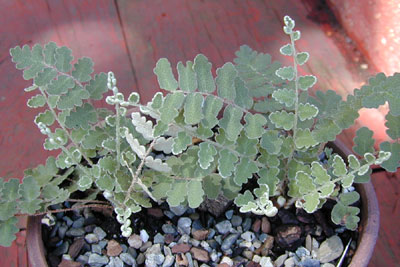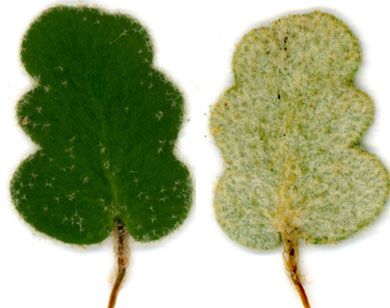|
Hardy Fern Home A. sinuata resources
All Ferns � Pteridaceae �� Astrolepis
�Other Genera
|
| Astrolepis sinuata | ||
Wavy cloak fern | ||
|
Etymology
From sinuo, to bend or curve, thus sinuata means having a wavy margin.
Description
Rhizome: short-creeping.
Frond: 45 cm high by 7 cm wide, evergreen, monomorphic, blade/stipe ratio: 7:1. Stipe: dull chestnut brown or straw-colored, rounded above, scales chestnut brown (or with a lighter margin), linear, vascular bundles: 2. Blade: 1-pinnate-pinnatifid (though some call the frond just pinnate with shallowly lobed pinnae), linear, tapering at base and apex, leathery, star-shaped scales on the upper surface, deciduous, brown or white hair-like scales below. Pinnae: 20 to 30 pair, 3-6 lobes per pinna; margins slightly downrolled; veins obscure, free, forking. Sori: clustered near notches between pinna lobes, along veins near margin, indusium: absent, sporangia: light to dark brown, maturity: summer to fall. Culture
Habitat: crevices, rocks and slopes, often on limestone .
Distribution: southwestern North America to southern South America, Caribbean, disjunct in Georgia, USA.
Hardy to -15�C, USDA Zone 7.
Distinctive Characteristics
This fern is highly variable in size with FNA reporting up to 130 cm. If young, the pinnae display diagnostic star-shaped scales. Otherwise, the combination of many lobed pinnae, the linear blade, the short, brown stipe, and the tan undersurface will not be matched elsewhere.
Synonyms
Acrostichum sinuatum Lagasca ex Swartz Cheilanthes sinuata (Lagasca ex Swartz) Domin Notholaena sinuata (Lagasca ex Swartz) Kaulfuss |
|
|

Astrolepis sinuata. Young plant. �Photo: Tom Stuart |

Astrolepis sinuata. Pinna top, left, with star-like scales, and bottom with white or tan hair-like scales. �Scan: Tom Stuart |

Astrolepis sinuata. Two vascular bundles in this genus, in contrast to one in the closely related Cheilanthes. Stipe scales as described. �Scan: Tom Stuart |
